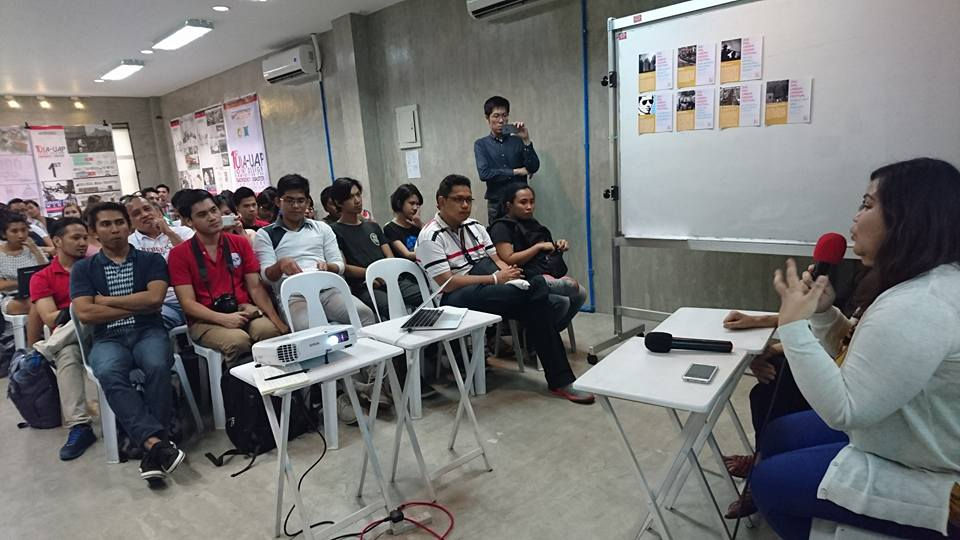Creating Women-Friendly Spaces After Disaster: A discussion at the 2nd Manila Urban Design Festival
- Pamela Gloria Cajilig

- Jun 25, 2016
- 3 min read
Updated: Sep 17, 2021
At the 2nd Manila Urban Design Festival, I had the wonderful opportunity to discuss the importance of creating women-friendly spaces after disaster with my women's rights mentor, Aida Santos. Aida, a pioneer in the women's rights movements in the Philippines, is founder of the Women's Education, Development and Productivity Research Organization (WeDpro), where I was once an advisor to the Board of Trustees. WeDpro and Curiosity, a design research firm I co-founded, has implemented several partnerships at the intersection of gender, design, and disaster. We were thrust into this work mostly during 2013 and onwards during the aftermath of Typhoon Haiyan (Yolanda). But we were already doing work at this juncture earlier than the typhoon - with collaborations as early as 2011 in the areas of communications strategy and communications design to address gender-based violence and to improve pathways to address violence against women (VAW), particularly VAW desk services in the province of Zambales.

Image 1. Philippine Women's Rights pioneer Aida Santos (left) and I discuss the importance of creating women-friendly spaces at the Curiosity Design Research space, a central venue of the 2nd Manila Urban Design Festival. Photo credit: Jaymie Divinagracia.

Image 2. Presenting to a full house at Curiosity. Photo credit: Jaymie Divinagracia.
During the talk, Aida underscored the surge of GBV cases post-disaster as women and girls strive to survive within a climate of diminished social protections for women. Many VAW victims continue to suffer with living with perpetrators out of desperation due to the decrease in socio-economic safety nets and opportunities. Disasters tend to disrupt and destroy government services and facilities that women turn to in order to seek assistance after experiencing VAW. These include destroyed hospitals and women's help desks located in damaged barangay halls. Aida discussed the importance of rebuilding women-friendly spaces as emphasised by policy frameworks, such Section 13 of the Philippine Magna Carta for Women:
SECTION 13. WOMEN AFFECTED BY DISASTERS, CALAMITIES, AND OTHER CRISIS SITUATIONS
Women have the right to protection and security in times of disasters, calamities and other crisis situations especially in all phases of relief, recovery, rehabilitation, and reconstruction efforts. The State shall provide for immediate humanitarian assistance, allocation of resources, and early resettlements, if necessary. It shall also address the particular needs of women from a gender perspective to ensure their full protection from sexual exploitation and other gender-based violence committed against them.
Responses to disaster situations shall include the provision of services, such as psychosocial support, livelihood support, education, and comprehensive health services, including protection during pregnancy.
WeDpro's work includes the urgent reconstruction of VAW desks in barangay halls and opening local gender and development centres. It also includes rebuilding barangay day care centres, an overlooked spatial aspect of disaster recovery. Women who belong to families affected by disaster may find themselves needing to seek employment or livelihood when they previously did not in order to boost household income for disaster recovery. The presence of child care facilities supports women hoping to increase their participation in socio-economic recovery, aside from benefitting to the psycho-social recovery of children.
During the talk, I discussed how building back better after disaster, however, not only includes building spaces for women but also with women. This includes Curiosity's work that emphasises the inclusion of women's perspectives in rebuilding efforts. In my experiences of doing ethnographic research within post-disaster housing reconstruction, I've often directly observed how women's views and concerns were sidelined by their husbands or by the very institutions who are responsible for their well-being after disaster. At Curiosity, we've paid special attention to how to communicate the significance of women's participation in rebuilding efforts. This includes mounting an interactive forum (still with WeDpro) on climate change and disaster resilience that was spearheaded by women. We also chose gender-neutral graphics in shelter communication work for WeDpro to evoke the sense planning and implementing rebuilding efforts need not only be a domain for men. This was placed in an area frequented by women - a day care centre.

Image 3. Shelter communications tarpaulin with gender neutral graphics. Image Credit: Elbert Or/Pushpin.

Image 4. Women examine our shelter communications while visiting a day care centre. Image credit: Pamela Cajilig.



![[Book Chapter] Typhoon Decision-Making for Non-Evacuation](https://static.wixstatic.com/media/8ecd68_520292e4e6f549c28a14511268e6fcc8~mv2.png/v1/fill/w_980,h_613,al_c,q_90,usm_0.66_1.00_0.01,enc_avif,quality_auto/8ecd68_520292e4e6f549c28a14511268e6fcc8~mv2.png)


Comentários